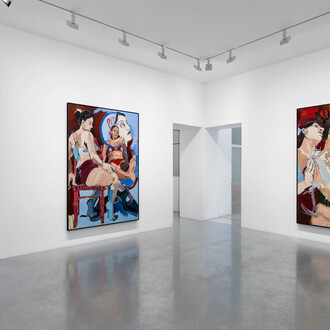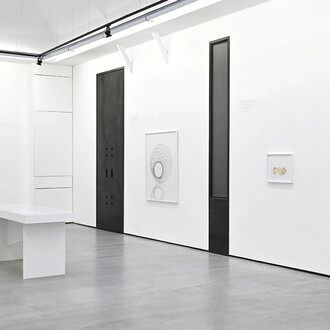Hypercycle, curated by art historian Matthieu Poirier, is a series of exhibitions at several sites across three continents from 2024 to 2026, with three chapters, each tracing a part of the artist’s career.
Lynn Chadwick (1914–2003) was one of the most significant sculptors of the twentieth century, alongside Alberto Giacometti, Henry Moore, and Louise Bourgeois. The first chapter begins on October 12, 2024 in Paris, at the Centre des Monuments Nationaux–Hôtel de Sully and Perrotin. It brings together sixty key works produced between 1947 and 1962, a time when the artist defined his unique approach and achieved international recognition. Lynn Chadwick’s sculptures are held in some 150 public collections worldwide, and this is the first time such an extensive selection of his work has been shown in France since his exhibition at the Musée National d’Art Moderne in Paris in 1957.
The second chapter covers his mature period, from 1963 to 1979, and will take place in New York in 2025. The third chapter, focused on his late work, from 1980 to 1996, will be held in Asia in 2026. A monograph is forthcoming in 2025, providing a full overview of Chadwick’s career and offering various perspectives on his work.
Sculpture of organic growth (1947-1962)
Born in 1914, Lynn Chadwick studied in London and, after living in Paris to learn French, worked as an architectural draftsman and a designer of furniture and textiles before becoming a pilot in the Fleet Air Arm during the Second World War. He began his artistic career in 1947 with a series of suspended mobiles. An unusual choice at the time, this art form implied physical movement, while depriving sculpture of its traditional mass and support. These works by Chadwick are abstract, but already full of naturalist echoes. Around 1951–1952, his sculptures left the air and, while still not submitting to gravity, seemed to step (or rather tiptoe) on the ground or on bases. These works sometimes took the form of stabiles that were articulated and flexible, but most often they depicted enigmatic “beasts” and other humanoid, stylised figures with atrophied heads and limbs. On the international scene, Lynn Chadwick was celebrated as embodying the renewal of postwar British sculpture, and he soon received many awards, such as the International Prize for Sculpture at the Venice Biennale of 1956.
Over a decade, he expressed a unique formal vocabulary based on angular geometry, with large works held up by complex material surfaces and thin supports with a precarious appearance. Critics saw in these works an existentialist gravity that was fitting for a time of reconstruction in England and Europe after the trauma of the Second World War. With his belief that “art must be the manifestation of some vital force coming from the dark”, Chadwick was connected to the artistic impulses of automatism, Art Informel, and Abstract Expressionism—although, as a sculptor, he was always on the margins of such movements. To him, sculpture had to stem from an instinctive, pragmatic approach and organic growth—not on the canvas, but in the space of geometry and three dimensions. Taking a different tack from the supple curves of his predecessor Henry Moore, the young sculptor was looking to the work of the constructivist Naum Gabo, the disturbing creations of Jacob Epstein, and the existentialist sculptures of Alberto Giacometti.
Inspired by recent discoveries in architecture and fascinated by the work of Charles Darwin, Chadwick worked tirelessly on the sculptural implications of the exoskeleton, including the shell of insects and the carapace of tortoises. In other words, he brought to the surface something that sculpture usually hides from view. Many of the artist’s bronzes resemble fossils, flayed or deprived of their surrounding flesh, as their geometrical sections also evoke medieval armour or even origami. Leaving London in the mid-1940s, Chadwick set up his studio in the Cotswolds, where in 1958 he purchased the neo-Gothic castle of Lypiatt. He transformed its dilapidated interiors into an immaculate white cube for his sculptures. He thus created a profound and lasting link between his artistic practice and the surrounding natural environment, with its gigantic trees, geographical features, flora and fauna. Combining the living and the architectural, and shaped by the artist-architect, this environment became both a setting for his work and a major source of inspiration.
During these crucial early years, Chadwick’s first recurring themes appeared, expressing his attention to modernist architecture and its metal load-bearing structures. Its influence was already palpable in his mobiles and his early bronzes, between 1951 and 1962, which evoke various fantastic animals, stylised couples with the appearance of insects, canines, and other faceted figures, whose protruding edges extend in space. As seen in their models, these sculptures were shaped by the soldering of metallic rods. The resulting works are various types of tetrahedrons and other shapes derived from triangles. The artist then filled in the empty spaces with small blocks of stone or coal and stolit, an industrial composite of plaster and iron fillings. Finally, he treated the exterior surfaces using various serrated tools, producing matter-based effects.
Chadwick created his forms instinctively, without sketching them in advance, as if to allow them to be animated by their own organic growth. His hybrid creatures, from their models to their bronze editions, did not spring from a compass and ruler, but from the hand of the artist and its extension: his welding torch. His ink drawings of these sculptures are included in this dual exhibition in Paris. Their concision and energy are remarkable, but they were always made in a second phase, following the production of the sculpture, usually for archival or documentary purposes.
This early work emerged from the synthesis of several different approaches. Chadwick explored biomorphism and a strange kind of coalescence between humans, animals, plants, mechanics and architecture. The theme of the couple, which appeared during this period and would continue to dominate throughout his career, revealed an androgynous, or even siamese, duality: in a pair, each figure is connected to the other by an extension, which is usually located near the waist. This strange organic symbiosis can also be seen in some sculptures depicting lone figures or animals, which, upon closer examination, seem to contain two separate bodies, connected by their thoracic cages.
In the fourth century BC, the Platonist philosopher Xenocrates studied the symbolism of triangles, defining the scalene triangle, with sides of unequal length, as “human”—the equilateral triangle as “divine”, and the isosceles triangle as “diabolical”. Concretely and metaphorically, this geometrical, elementary and unstable shape forms the genetic nucleus of Lynn Chadwick’s work and defines his humanism. With its modular and spatial extensions (the tetrahedron and related shapes), this unit has an underlying stylised vitality—an oxymoron that continues throughout the artist’s oeuvre. And it just so happens that the protruding muscles of the neck, which are responsible for connecting the head and the body and for postural movement, are called scalenes—a key subject of classical sculpture if ever there was one.
During this seminal period of his career, Chadwick’s geometrical spirit drew upon constructivism and modernist architecture. This spirit was truly embodied in the material body of the sculpture, turning back to the living and to the reality of nature, from which geometry itself was originally deduced. The profoundly hybrid and mysterious creatures that populate the grandiose exterior of the Hôtel de Sully and the sober environment of Perrotin contained energy, and their apparent vulnerability, they speak to our own condition as viewers, like the moai heads of Easter Island or the ancient sculpted canines of the island of Delos, eternal guardians and witnesses of humanity, that fascinated the British sculptor.
(Text by Matthieu Poirier, art historian)
















